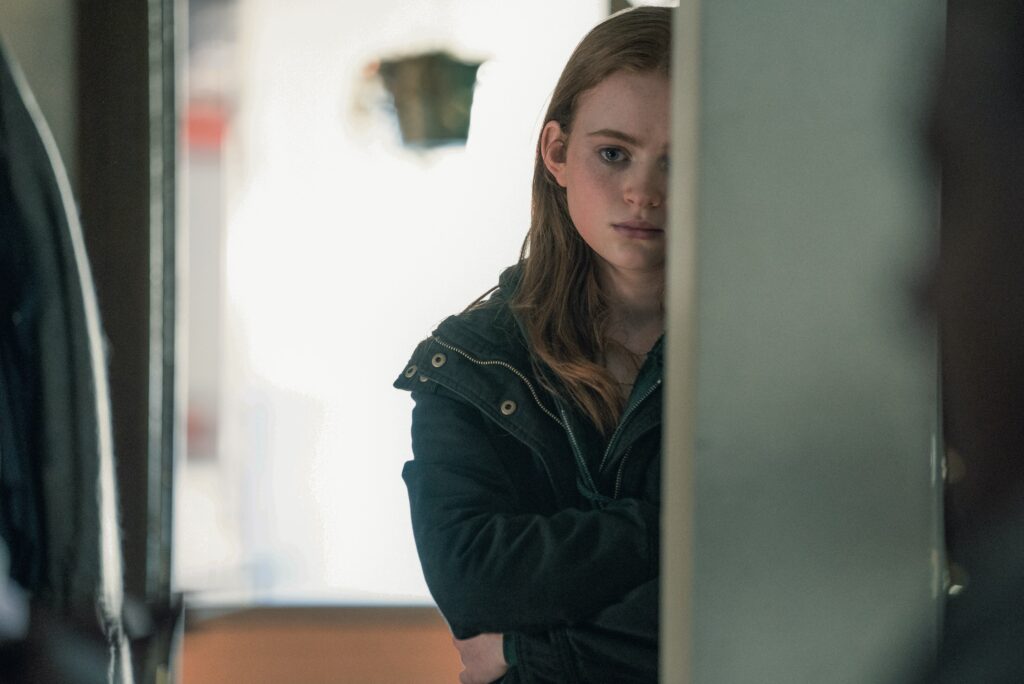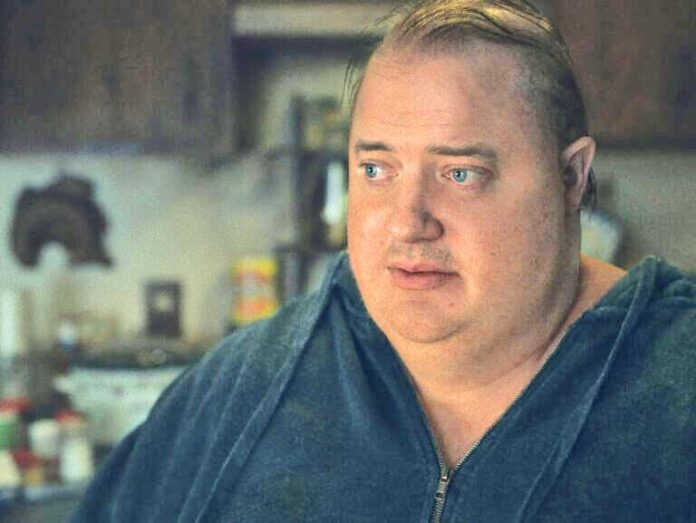In “The Whale,” opening December 23, Charlie (Brendan Fraser) a gay man, is first heard, and not seen. He is teaching an online class about writing essays and explains that his laptop camera does not work. In the next scene, Charlie is seen, and it is shocking — and not just because he is masturbating to gay porn when Thomas (Ty Simpkins), a missionary, drops by. It because Charlie is severely obese.
Director Darren Aronofsky’s screen adaptation of the play by out gay writer Samuel D. Hunter is built around Charlie, and Fraser commands the screen literally and figuratively. The film is shot in a 1:33:1 aspect ratio which squares the frame, condensing the space and making scenes focus tighter on the character. So, watching Charlie with all his girth, stand, walk, or even shower (in a scene that will satisfy the perversely curious) viewers will feel the effort required to achieve these simple tasks. There is power in Fraser’s performance in his wheezing and the sadness in his eyes that is heartbreaking, but the actor’s best moments are these scenes where he goes “small,” and internalizes what he is feeling — even if he is eating those feelings. This is a film about Charlie’s shame about his weight, and his sexuality, as well as his grief, and loss. It is about giving up while offering a glimmer of hope amid all the despair.
But as strong of a showcase as “The Whale” is for Fraser, who will likely be Oscar nominated for his work here, the film itself is rather disappointing. It only glosses over the issues rather than explores them in any depth. Charlie is meant to be gawked at and pitied — and the film lets viewers do both. It is meant to jerk tears, but it feels manipulative.
Charlie has congestive heart failure and refuses to go to the hospital because he has no insurance. He prefers the company of Liz (Hong Chau in an excellent performance), who cares for him and manages his needs. Liz, it is revealed later in the film, knew Charlie’s late partner, Alan, and it was after Alan’s untimely death that Charlie let the eating “get out of control.”

Now that Charlie is near death, he hopes to reconnect with his teenage daughter, Ellie (Sadie Sink), whom he left (to be with Alan) when she was 8. Ellie is still bitter and reluctantly reaches out to her estranged father. She is failing school and wants his help but is not sure how to ask for it. Meanwhile, Thomas, the missionary, returns from time to time hoping to give Charlie some spiritual guidance and even save his soul. Thomas also forms a connection with Ellie.
“The Whale” is a stage bound film, and that makes sense given the source material and the fact that Charlie is not very mobile. But Aronofsky cudgels viewers with symbolic rain almost every time the front door is opened, or a bit involving the bedroom he and Alan shared that is locked off as if sealed from memory. (An interesting episode/metaphor has Charlie finding and dropping the key and needing Thomas to help him recover it.)
There are also “hard to watch” scenes of Charlie stuffing his face with candy bars, a bucket of fried chicken, or putting mayonnaise on a slice of pizza. (He has two pies delivered to him nightly.) Charlie knows he is disgusting, and he tries to get Ellie and Thomas to acknowledge this because what he wants most of all is honesty.
Honesty is also what he craves in the essays he reads — he has one on “Moby Dick” (another obvious symbol/metaphor) that he especially loves. When Ellie writes some lines in a notebook, he marvels at her impromptu haiku. When Thomas talks about spirituality, Charlie counters him with his knowledge of the bible. The most honest scenes in the film may be those featuring his ex-wife, Mary (Samantha Morton, outstanding). Like Ellie and Liz, Mary is feisty and does not pull punches with Charlie, which may be why their conversations have some sizzle. She confronts him about their life together and apart, and it gives a fuller picture of things, including a cliched flashback of a family trip to the coast.
Too much of what happens in “The Whale” feels obvious or underdeveloped. Liz indulges many of Charlie’s requests, but their relationship is a way of clinging to the late Alan. Liz does have a heart-to-heart with Thomas where she explains what happened to Alan, that is quite moving. Likewise, Thomas and Ellie have an exchange where she challenges him, and he reveals some unexpected truths. These scenes flesh out the supporting characters more, but the film never provides enough insight into the grieving Charlie.
And this may be one of the problems with “The Whale”: Charlie and his character are only skin deep. His sexuality contributed to his marriage dissolving, and his estrangement from his daughter, as well as his overeating after Alan’s death. (A point is made that Charlie could not identify his lover’s body since he was not related to Alan.) But does this all make Charlie a big symbol for a self-hating gay man? (Thomas experiences gay panic when he mistakenly thinks Charlie is interested in him.) Moreover, as Charlie offers to pay Ellie for her company, the film goes for cloying sentiment, “Who would want me to be a part of their life?” the self-pitying Charlie asks in a pointed and oh-so-poignant moment.
“The Whale” is also full of preachy discussions about salvation and includes a magical realist moment in the film’s end that is meant to be graceful but feels clunky. The performances aside — the entire ensemble cast is strong — Aronofsky’s heavy-handed film is crushed by the weight of its own self-importance.
